
The Oratory of the Madonna of San Colombano, also called the Chiese di San Colombano e Santa Maria dell'Orazione is a religious site in central Bologna, found on Via Parigi #5, near the Bologna Cathedral.

The Oratory of the Madonna of San Colombano, also called the Chiese di San Colombano e Santa Maria dell'Orazione is a religious site in central Bologna, found on Via Parigi #5, near the Bologna Cathedral.
The oratory was built in 1591, atop the site of a chapel or small church that sheltered the painting of the Madonna dell’Orazione by Lippo di Dalmasio. The church, called San Colombano, at the site had been founded in the 7th century by Peter I, the bishop of Bologna and pupil of the Irish monk Columbanus. Columbanus had died in nearby Bobbio.
The annexed oratory contained a revered icon of the Virgin by Lippo Dalmasio as a main altarpiece. Starting about the year 1600, it was decorated by an impressive series of pupils of Ludovico Carracci, among them some of the titans of early Italian Baroque painting: Francesco Albani, Francesco Brizio, Domenichino, Lorenzo Garbieri, Lucio Massari, Guido Reni, and Baldassare Aloisi (il Balanino). The frescoes include scenes from the Passion and Resurrection of Christ.
Among the paintings listed by Malvasia in the Oratory are: [1] [2]
In the upper oratory, the frescoes include a St Peter going out weeping from Pilate’s house by Francesco Albani.
The property now belongs to the Fondazione Cassa di Risparmio in Bologna, and is being restored. Restorations have uncovered earlier 13th-century frescoes. [3]
The attached complex of buildings, since 2010, houses the collection of musical instruments donated by Luigi Ferdinando Tagliavini, consisting of nearly ninety pieces including harpsichords, spinets, pianofortes, clavichords and others. It also houses the musical library of Oscar Mischiati. [4]

Guido Reni was an Italian Baroque painter, although his works showed a classical manner, similar to Simon Vouet, Nicolas Poussin, and Philippe de Champaigne. He painted primarily religious works, but also mythological and allegorical subjects. Active in Rome, Naples, and his native Bologna, he became the dominant figure in the Bolognese School that emerged under the influence of the Carracci.

Pietro Perugino, an Italian Renaissance painter of the Umbrian school, developed some of the qualities that found classic expression in the High Renaissance. Raphael became his most famous pupil.
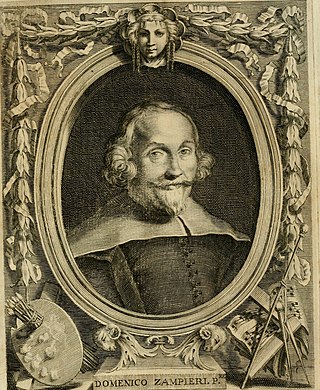
Domenico Zampieri, known by the diminutive Domenichino after his shortness, was an Italian Baroque painter of the Bolognese School of painters.
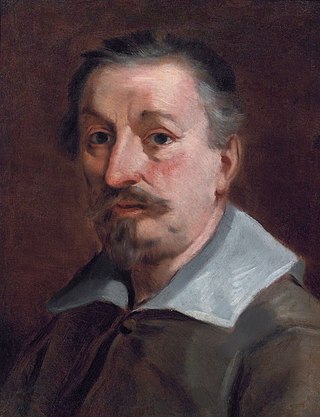
Francesco Albani or Albano was an Italian Baroque painter of Albanian origin who was active in Bologna, Rome, Viterbo (1609–1610), Mantua (1621–1622) and Florence (1633).

Carlo Cignani was an Italian painter. His innovative style referred to as his 'new manner' introduced a reflective, intimate mood of painting and presaged the later pictures of Guido Reni and Guercino, as well as those of Simone Cantarini. This gentle manner marked a break with the more energetic style of earlier Bolognese classicism of the Bolognese School of painting.
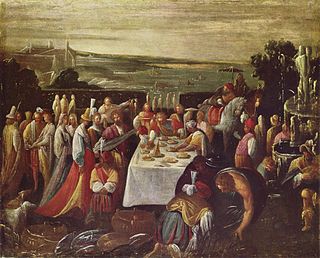
Giovanni Andrea Donducci (1575–1655), also known as Mastelletta, was an Italian Baroque painter of the Bolognese School (painting). His father was a maker of vats (mastelli). Born in Bologna, he trained in the Carracci Academy degli Incamminati at about the time when Domenichino, Lucio Massari, and perhaps Albani were there.
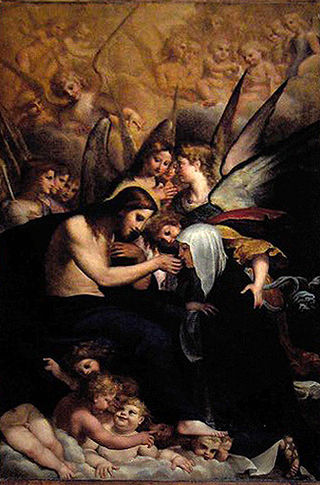
Francesco Brizio (1574–1623) was an Italian painter and engraver of the Bolognese School, active in the early-Baroque.

Angelo Michele Colonna was an Italian painter of the Baroque period, active in Bologna, northern and central Italy and Spain. He is sometimes referred to as Michelangelo Colonna.
Giovanni Battista Bertusio was a painter of the early-Baroque period, active in Bologna. He trained initially under Denys Calvaert, then under Ludovico and Agostino Carracci. He married the painter Antonia Pinelli.

Antonio Randa was an Italian painter of the classicist period, active in Ferrara, Modena, Rovigo, Florence, Comacchio and his native Bologna.

The Basilica of San Domenico, also known as Basilica Cateriniana, is a basilica church in Siena, Tuscany, Italy, one of the most important in the city. The basilica is an example of Cistercian Gothic style.

San Martino church, also called San Martino Maggiore is a Gothic-style, Roman Catholic church located at the corner of Via Marsala and Via Guglielmo Oberdan in Bologna, region of Emilia Romagna, Italy. The church was founded by the adjacent Carmelite monastery. On 10 August 1704 via the authority of the Vatican Chapter, the venerated image of the Virgin of Mount Carmel was crowned by Pope Clement XI. On 25 August 1941, Pope Pius XII elevated it to the status of basilica.

Pietro di Giovanni Lianori was an Italian painter, active in Bologna.
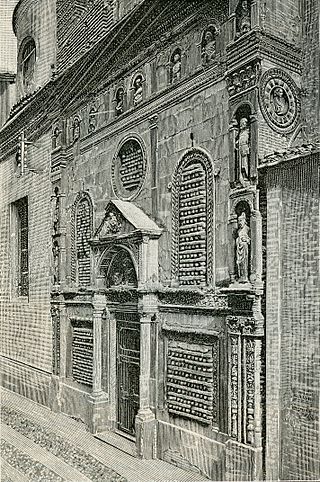
The Madonna di Galliera is a church with a Renaissance facade and Baroque interiors, located on Via Manzoni, in central Bologna, Italy. It stands in front of the Palazzo Ghisilardi Fava. The present name over the portal is the Chiesa di Filippini Madonna di Galliera e Filippo Neri.

The Sanctuary of Santa Maria della Pioggia is a small church, located on Via Riva Reno 122, between Galliera road and Riva di Reno road in central Bologna, Italy. It was once the Oratory of San Bartolomeo di Reno.

Santa Cristina or Santa Cristina della Fondazza is a deconsecrated Roman Catholic church and adjacent former convent, located on Piazzetta Morandi in central Bologna, region of Emilia Romagna, Italy. Since 2007, the barrel-vaulted church has served as a performance hall for concerts, mainly of choir and classical formats, while the convent houses the Department of Visual Arts of the University of Bologna.

The Sanctuary of the Madonna del Baraccano is a Renaissance style, Roman Catholic church, located at Piazza del Baraccano 2 at the southern edge of the formerly walled central Bologna, region of Emilia-Romagna, Italy. The church was built at the site of city wall, where a Madonna image was painted, hence called Madonna of the Barricade. Presently much at the site is undergoing restoration after the May 2012 earthquake.
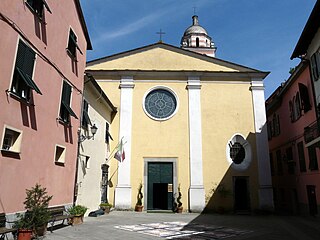
Brugnato Cathedral is a Roman Catholic cathedral located in the old centre of the city of Brugnato, in the Val di Vara in the province of La Spezia, Italy. The dedication is to Saint Peter, Saint Laurence and Saint Columbanus. Once the seat of the bishops of Brugnato, it is now a co-cathedral in the Diocese of La Spezia-Sarzana-Brugnato.

Ferrara Charterhouse, of which the present Church of San Cristoforo alla Certosa was previously the monastic church, is a former charterhouse or Carthusian monastery built in Renaissance style, located on Piazza Borso 50 in Ferrara, Region of Emilia-Romagna, Italy. The monastery was suppressed in the time of Napoleon, but the church was reconsecrated in 1813 and remains in use. The site also accommodates a large municipal cemetery, which was established in 1813.

Madonna and Child with Saints, Madonna and Child Enthroned with the Infant St John the Baptist, St John the Evangelist and Saint Catherine of Alexandria or the San Giorgio Madonna is a 1593 oil on canvas painting by Annibale Carracci, originally in the Landini chapel in the church of San Giorgio in Poggiale, Bologna. During the 19th century the conservation conditions there worsened and it was moved to the Accademia di Belle Arti for restoration, before being moved to its current home in the then-new Pinacoteca Nazionale di Bologna.. It is signed and dated "ANNI CARR FE MDXCIII".